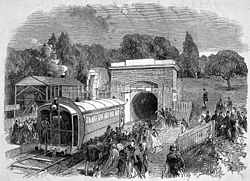- Crystal Palace pneumatic railway
-
Crystal Palace Pneumatic / Atmospheric Railway 
Engraving of the Crystal Palace line (1864)Dates of operation 1864–c.1865 Predecessor None Successor Waterloo and Whitehall Railway Track gauge Broad gauge Length 600 yards The Crystal Palace pneumatic railway (also known as the Crystal Palace atmospheric railway) was an experimental atmospheric railway constructed near Crystal Palace Park in South London c.1864.
Contents
History
The railway was designed by Thomas Webster Rammell, who had previously built an atmospheric railway for the London Pneumatic Despatch Company to convey letters along vacuum-driven tunnels in large wagons. A similar principle was applied to this railway, by which a carriage, which had been fitted with a large collar of bristles, would be sucked along an airtight tunnel that measured 10 feet (3.0 m) by 9 feet (2.7 m).[1]
The power was provided by a large fan, some 22 feet (6.7 m) in diameter, that was probably powered by a steam engine.[2][3] On return journeys, the fan was reversed to create a vacuum to suck the carriage backwards, whilst the carriage itself needed to use its own brakes to come to a stop.[4]
Operations
The tunnel ran for 600 yards (550 m) between the Sydenham and Penge entrances to the park, and had to negotiate a difficult bend along the line. Tickets cost sixpence each.[5] Trains ran between 1pm and 6pm and the journey-time as a whole took a mere 50 seconds.[6]
Legacy
It is unclear what became of the line, as records do not state when it ceased to operate, although it has been suggested that Rammell had originally constructed the small line as a test for a larger atmospheric railway that was to run between Waterloo and Whitehall.[7]
It has been rumoured that the site of the railway is haunted, which was a popular urban legend of the 1930s partially connected with stories surrounding Crystal Palace railway station.
In 1978, a woman claimed to have found the tunnel and to have seen within it an old railway carriage filled with skeletons in Victorian outfits.[8] The tunnel was not found, and some believed that the tunnel may have been destroyed by construction work for the Festival of Empire celebrations in 1911.[5]
See also
- Beach Pneumatic Transit – A similar atmospheric railway operating in America
References
- ^ Hadfield, C. (1967) Atmospheric Railways: A Victorian Venture in Silent Speed Newton Abbot: David & Charles
- ^ "Frederic Delaitre's Lost Subways / Crystal Palace Atmospheric Railway". Fdelaitre.club.fr. http://fdelaitre.club.fr/Crystal.htm. Retrieved 2010-04-18.
- ^ "Crystal Palace Park" (PDF). http://www.lda.gov.uk/upload/pdf/Crystal_Palace_Park_-_Conservation_Plan_20050419142008.pdf. Retrieved 2010-04-18.
- ^ Hadfield, C. (1967) Atmospheric Railways: A Victorian Venture in Silent Speed Newton Abbot: David & Charles
- ^ a b "Making History – The Crystal Palace atmospheric railway". Capsu.org. 2001-12-04. http://www.capsu.org/library/documents/0040.html. Retrieved 2010-04-18.
- ^ Hadfield, C. (1967) Atmospheric Railways: A Victorian Venture in Silent Speed Newton Abbot: David & Charles
- ^ IanVisits (2007-02-23). "IanVisits… » The Waterloo and Whitehall Pneumatic Railway". Ianvisits.co.uk. http://www.ianvisits.co.uk/blog/2007_02_23/the-waterloo-and-whitehall-pneumatic-railway/. Retrieved 2010-04-18.
- ^ Herbert, W.B. Railway Ghosts and Phantoms (ISBN: CN1361)
Categories:- Alternatives to conventional railways
- Closed railway lines in London
- Railway lines opened in 1864
- Pneumatics
Wikimedia Foundation. 2010.
